Periodically we receive important questions from service technicians and appliance installers pertaining to the model AFG oil burner. This article, which is an update of the bulletin originally released in August 1998, will address the most frequently asked questions.
1. WHAT IS STATIC PRESSURE, AND WHY IS IT IMPORTANT WITH TODAY’S APPLICATIONS?
Static pressure refers to the amount of compressive or expansive energy in a fluid or gas. This energy will be present whether the fluid or gas is in motion or at rest. Static pressure is the means of producing and maintaining flow against a resistance.
High static pressure burners have been developed to accommodate the more modern, flow restrictive appliances and to assist with low draft conditions. A drop in static pressure can cause problems that range from delayed ignition, rumbles, and pulsation to the inability to adjust the burner for clean operation. In these cases, more static pressure is required to ensure uniform, dependable combustion performance under variable conditions.
The air handling components of the AFG enable it to develop greater static pressure than the conventional model AF burner (FIGURE 1). The fan in a high static pressure burner starts with enough high pressure to effectively push the products of combustion through the appliance without interruption. The higher static pressure also acts like a shock absorber or tightly wound spring during the cycle to resist and absorb flame pulsations. This is especially needed in most modern appliances, which are designed with more efficient heat exchanger passages and increased draft loss for greater heat transfer.
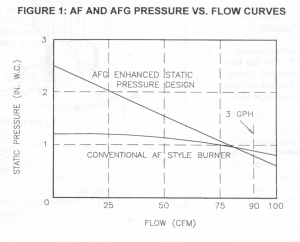
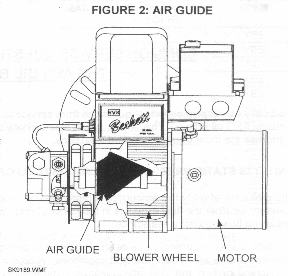 2. HOW DOES THE AFG ACHIEVE ITS HIGHER LEVEL OF STATIC PRESSURE?
2. HOW DOES THE AFG ACHIEVE ITS HIGHER LEVEL OF STATIC PRESSURE?
A vital part of the AFG design is a stationary piece of black plastic installed inside the burner housing. This device is known as the “air guide”. The air guide’s purpose is to direct the air into the optimal point of the specially designed tablock blower wheel (FIGURE 2). This allows it to develop a greater static pressure than the model AF style wheel, yet maintain the same quantity (cfm) of air flow.
WARNING! Do not operate the AFG burner without the air guide installed. If the air guide is removed, the burner could be seriously disabled, and the performance severely affected. Delayed ignition, puffback, and appliance soot up could result.
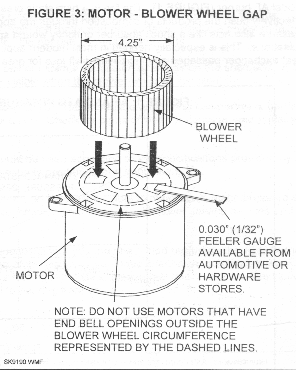 3. WHEN REPLACING THE MOTOR, WHAT FACTORS SHOULD BE KEPT IN MIND?
3. WHEN REPLACING THE MOTOR, WHAT FACTORS SHOULD BE KEPT IN MIND?
The specified motor for the AFG is either of the closed end type or has small openings in the end bell at the motor shaft end. The small openings are covered once the fan wheel is installed onto the motor. The back plate of the wheel is positioned close to the motor end bell with a gap setting of 0.030″ (approximately 1/32″) for maximum efficiency and output (FIGURE 3).
Use of a motor style with openings which are not covered once the fan wheel has been installed will cause a lack of static pressure at the burner retention head due to leakage and turbulence.
Use a 0.030″ (1/32″) thickness feeler gauge to measure the gap between the motor and the blower wheel. Place the gauge flush to the top of the motor and bottom of blower wheel as shown in FIGURE 3. The set screw must be centered on the flat of the motor shaft. Tighten the set screw.
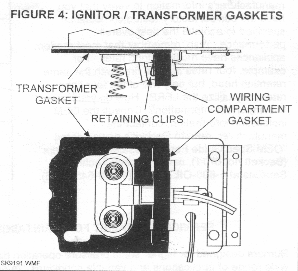 4. WHAT PURPOSE IS SERVED BY HAVING GASKETS ON THE TRANSFORMER OR IGNITOR BASEPLATE?
4. WHAT PURPOSE IS SERVED BY HAVING GASKETS ON THE TRANSFORMER OR IGNITOR BASEPLATE?
The housing is sealed on the underside of the ignition unit with gaskets (use kit part no. 51304) to prevent loss of static pressure caused by air leakage around the baseplate.
Note: On a job site where you are experiencing mild rumbles at start up, shut down, or during the running cycle, a missing gasket (FIGURE 4) may be contributing to the condition and should be included in your investigation. Air leakage from the burner housing will reduce the valuable static pressure needed at the flame retention head.
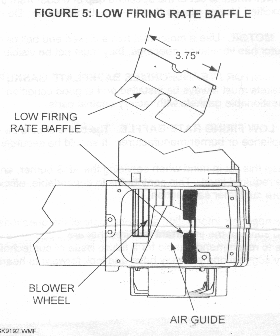 5. WHAT IS THE LOW FIRING RATE BAFFLE, AND WHEN SHOULD IT BE USED?
5. WHAT IS THE LOW FIRING RATE BAFFLE, AND WHEN SHOULD IT BE USED?
The low firing rate baffle, or LFRB (FIGURE 5), was designed to control the air flow at the discharge of the blower wheel. The baffle reduces the volume of air from the blower. This allows the air shutter or band to be set with larger openings while achieving the same combustion performance readings. When firing low rates in dusty, lint-laden areas, the wider air openings that accompany the installation of the LFRB help to ensure trouble free operation by reducing the possibility of air inlet blocking.
A secondary function of the LFRB is to regulate the quantity of high velocity air through the center of the retention head. This improves ignition and flame stability. When retrofitting burners with the LFRB, refer to the chart on page 4 for basic guidelines.
For pretested I packaged burners, refer to the manufacturer’s information to verify that you have the correct factory-tested combination specified to achieve the best overall performance. Also, remember that most modern appliances have multiple firing rates. For example, four rates may be fired with the same retention head, but only two of the four firing rates may utilize the LFRB. How do you locate this important information? Consult the OEM installation information, contact the manufacturer, refer to Beckett’s new updated “OEM Spec Guide For Wholesalers & Installers” (Beckett no. 6711), or call Beckett Technical Services at 1-800-OIL-BURN (1-800-645-2876).
MIGHT I NEED THE LOW FIRING RATE BAFFLE?
| HEAD | FIRING RATE (GPH) |
LFRB |
| F0 | 0.5 | Yes |
| 0.65 | Yes | |
| 0.75 | No | |
| F3 | 0.75 | Yes |
| 0.85 | Yes | |
| 0.90 | No | |
| 1.00 | No | |
| F6 | 0.85 | Yes |
| 0.90 | Yes | |
| 1.00 | No | |
| L1 | 0.75-0.85 | Yes |
| V1 | 0.75-1.00 | Yes |
SERVICE CHECKLIST FOR MAINTAINING ADEQUATE STATIC PRESSURE
Burners designed for higher static pressure operation deliver exceptional combustion performance over a wide range of applications and variable conditions. In order to obtain the maximum benefits from this improved design, always give careful attention to the following requirements:
1. AIR GUIDE. Make sure the air guide is correctly installed and free from any damage or debris.
2. BLOWER WHEEL. Thoroughly clean the fan blades during the scheduled tune up. Verify that the blower wheel is set to the specified gap of 0.030″ from the motor end bell surface. Replace only with factory specified blower wheels that are exactly the same. Do not use non-equivalent parts.
3. MOTOR. Use a motor that has a closed end bell or minimal ventilation openings on the shaft end. If the motor has ventilation openings, they must not be visible when the blower wheel is installed.
4. IGNITOR I TRANSFORMER BASEPLATE GASKETS. The baseplate and wiring compartment barrier gaskets must always be installed and in good condition. Check for signs of wear or damage, and replace questionable gaskets with factory original parts.
5. LOW FIRING RATE BAFFLE. The baffle should be used according to the specifications provided by the appliance or burner manufacturer. It should be securely positioned and kept clean.
Keep this list in mind when servicing the AFG burner, and you will be able to maintain its static pressure at the required level. This contributes to dependable, efficient performance, with fewer service hassles and more customer satisfaction.
We hope this information answers some of the questions that you may have had regarding the AFG burner and some of the important features that are a part of its design. If you have a technical question or would like to recommend a topic for a future issue of our technical bulletins, please feel free to call us. We value any suggestions you may have and look forward to hearing from you.

Leave A Comment